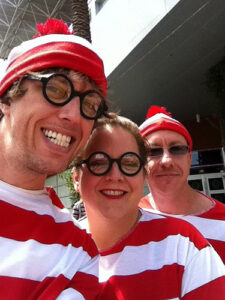Disclaimer: I am not a lawyer. This blog should not be viewed as legal advice. It is simply my experiences, opinions, and information I looked up on the internet.
It appears the term “flash mob†is being used inappropriately and its meaning is being overly broadened to include any group activity that is coordinated using social media. This year, there have been several robberies and assaults perpetrated by a group of people that appear (at least on the surface) to have been orchestrated via social media sites. The media has called them “flash mob crimes.â€Â They make it sound like someone created a Facebook event that said, “Meet at Broadway and Main at 10pm. At exactly 10:03, we’re all going to run into the minimart, grab whatever we want, and run out.â€Â That’s not a flash mob. That’s solicitation and possibly conspiracy. If the event actually occurs, it’s larceny and perhaps inciting a riot.

A flash mob is defined as “a group of people who assemble suddenly in a public place, perform an unusual and sometimes seemingly pointless act for a brief time, then disperse, often for the purposes of entertainment and/or satire.â€Â Flash mobs have been occurring at least since the 1970’s. In recent years, they have been orchestrated via email and social media websites; however, that does not mean that every public group activity that is coordinated via social media is a flash mob.
Flash mobs are generally light-hearted innocuous fun. People who participate in flash mobs ride public transportation without their pants; they welcome back strangers at the airport; they have fake battles between heroes and villains; and they stand frozen in place for short periods of time. Some protests and promotional events are referred to as “flash mobs,†but technically they’re not. And any event that has a criminal intent is definitely not a flash mob.
I give the media some leeway when it comes to coining terms; however, I was deeply disturbed when I saw a legal website refer to flash mobs as including criminal behavior. It suggests the writer did not do their research on this topic.
I love flash mobs. I have been participating in them and organizing them since 2009. When Improv AZ organizes a flash mob, we do thorough research on the potential legal implications of our event. I have attended an event with pages of statutes in my back pocket to ensure that we’re acting within the confines of the law. We are diligent to inform our participants in advance of their do’s and don’ts. We may push the envelope, but we never intend to cross the line. Most of our encounters with police involve them smiling or laughing at us. At the 2010 No Pants Ride after party, a Tempe police car stopped near us and an officer yelled out, “We had a briefing about you!â€Â And then he went about his merry way, knowing we were harmless.  A bit odd and rather goofy, but harmless.
Flash mobs are harmless, playful, and unexpected events. They are not criminal acts by design. Flash mobs and crimes are two completely different phenomena. They do not exist on the same continuum.
In other news, the flash mob community needs to send a big “thank you” to Mayor Jackson and the city of Cleveland.  Mayor Jackson recently vetoed a proposed law that would have made it illegal to use social media to coordinate a flash mob. Thank you for protecting our First Amendment rights!





